Get a Clue: Crack the Case with Bally's 1995 WHO dunnit

1995 marked an interesting year for pinball development; along with SEGA making marked improvements in their pinball machines, Williams / Bally opted to put out the widest variety of different pinball machines they had put out in a while, all with much higher scoring than previous tables. While Attack from Mars and Johnny Mnemonic are two incredibly fast and flowing tables from this year, tables like Jack*Bot and today’s tutorial subject, WHO dunnit, are more stop-and-go but compensate for their slow nature with high scoring and unique themes. Though WHO dunnit was the brainchild of Barry Oursler, the game’s design and software were handled by Dwight Sullivan, who opted to use this machine to introduce some new ideas to pinball progression that are still being used today, including equipment that gives perks throughout the game and a story that continues across every play of the machine.
WHO dunnit is a murder mystery-themed pinball table that effectively plays out as the board game “Clue”, but on a pinball machine and with its progression and scoring. Though a very fun and different table from its contemporaries, this table is not used in competitions often due to a super skill shot exploit & random aspects that can’t be changed in the settings, and is generally considered to be a long-playing machine. But if you’re looking for a fun table to sink your teeth into on location, WHO dunnit is one of the best suspects out there – casuals will enjoy the slot and elevator mechanics while advanced players will focus on trying to complete as many cases as possible. Not to mention, roulette is certainly one of the more thrilling rules in a pinball machine I’ve seen for sure!
About WHO dunnit
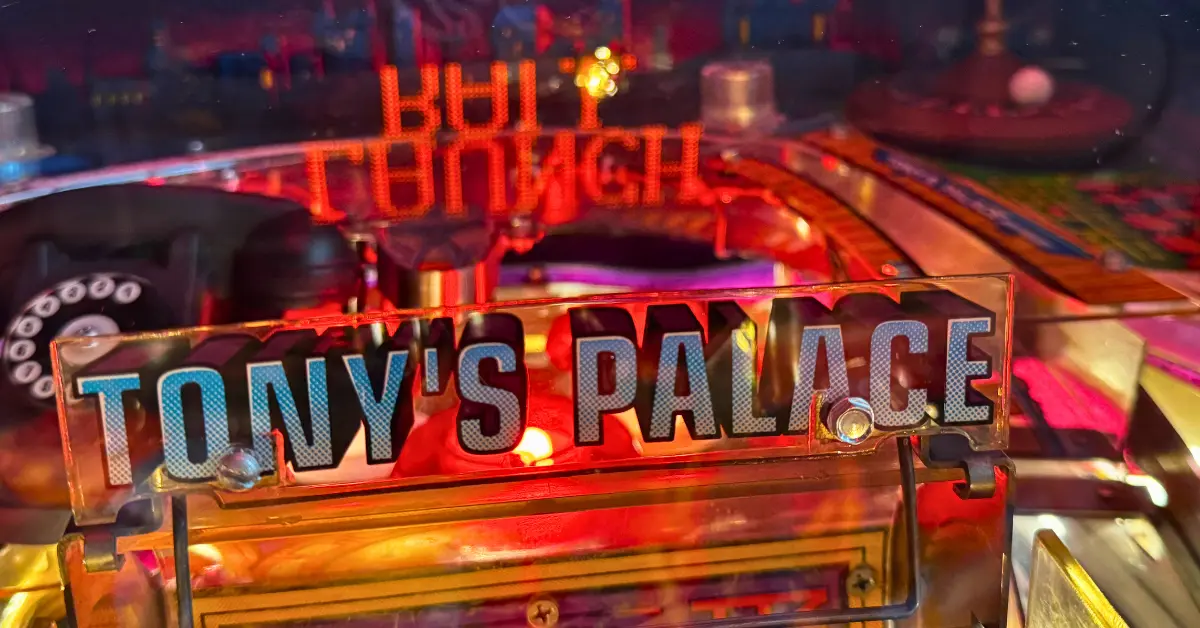
Tony’s Palace is a casino whose owner, Tony, and bouncer, Bruno (Tex), are tangled in a web of deceit alongside its other employees. As Nick Spade, the player must unravel “WHO dunnit” by interrogating the suspects, all while exploring the casino for evidence and gambling their winnings away. This 1995 pinball machine more heavily emphasizes story and progression than its contemporaries.
- Manufacturer: Bally
- Release Year: 1995
- Design: Dwight Sullivan, Barry Oursler
- Code: Dwight Sullivan
- Mechanics / Electronics: Zofia Bil
- Art: Linda Deal, Paul Barker
- Displays: Adam Rhine, Brian Morris
- Music / Sound: Paul Heitsch
Playfield Overview
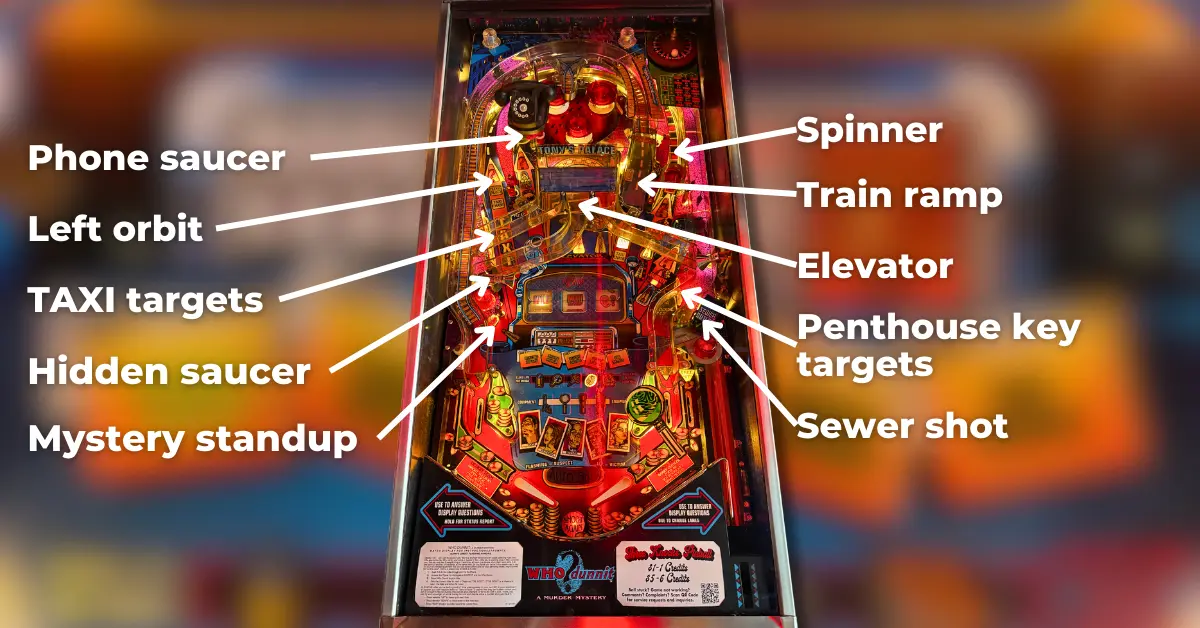
WHO dunnit is a “fan” layout, but one with more saucers and scoops than most, to accommodate the need for places to hold the ball during interrogations. The far-left side of the playfield has an interesting design, with a hidden saucer that can only be accessed via the plunger, the elevator exit, or via lucky bounces into it. In front of the left saucer is the mystery standup target, which will help the player out whenever it is lit via hitting the penthouse key targets on the far-right side of the table. Also gating the left saucer are four standup targets spelling TAXI, which also can’t be hit directly, but the orbits can assist with collecting TAXI letters, and the plunger can also send the ball into any of the four targets. The left orbit is parallel to the TAXI targets and either sends the ball to the bumpers or around to the right flipper if taxi chase is lit.
There are two “main shots” on WHO dunnit: the phone and the elevator. The phone saucer is a narrow shot best hit from a cradle on the right flipper and is the main method of interrogating suspects and choosing WHO dunnit once clues have been found. The elevator, meanwhile, is wide open and has three different exits: one moves the elevator up, one moves it down, and the center shot exits and collects the award for whatever floor the player exits on. A 3-bank standup target just like the one on Attack from Mars blocks the elevator any time an award is scored, and sporadically during multiball modes. Behind the elevator is an array of three pop bumpers that nudge the slots, with a hole below them that registers that the slots have been spun, and a post above to direct unlit left orbit shots into the bumpers.
The right side of the playfield is occupied by three shots. The game’s only other ramp is the train ramp, which feeds the left flipper for repeated shots and attempts at train combos but can also raise to reveal the opposite side of the left orbit if taxi chase is lit and during most multiball modes. The spinner shot feeds a post under the roulette and sends the ball to the right flipper, ideal for ski passing back to the left flipper; hitting this shot once will light the roulette if it isn’t already lit. The sewer shot is on the far right of the playfield and sends balls to the right flipper; it contains a fourth ball that releases when roof multiball begins and will keep the ball locked there the next time it is hit during normal play.
Between the left orbit and phone shot is a “red” standup target, with a “black” standup target located between the right elevator ramp and the train ramp; both are used to determine the next roulette bet and can be hit at any time during play even if the roulette isn’t currently available. The inlanes and outlanes have a light that cycles across them like the one on White Water; keeping the outlanes lit can award free slot spins with the potential for second chance or multiball, essentially acting as ball saves.
Scoring on WHO dunnit is average for a 1995-era Williams table. Expect scores on par with Jack*Bot where a billion would be a good game, with the best players being able to surpass 10 billion and onwards. Of course, the roulette can assist with making these score barriers less intense, though it will also be more than willing to mess you up if you already have a good score.
Getting Started with WHO dunnit

- Skill shot – aim for the flashing letter in TAXI, best ones are A for clue and X for bonus multiplier. There is a super skill shot if you plunge into the left saucer that can be scored repeatedly if you drain the ball thanks to playfield validation.
- Three steps to solving a case and starting roof multiball:
- Interrogate suspects – spell TAXI to collect clues and light the phone for interrogations. The taxi chase light at the inlanes allows orbits to spot TAXI letters.
- WHO dunnit – after interrogating a suspect, the phone will light to select a suspect. The suspect will always be discussed during the first interrogation unless they talk about someone unrelated to the requested suspect.
- Catch the killer – select the right suspect to start a chase on the roof. Hit either the right orbit or left orbit (alternate on a timer) to light the phone for 100M hurry-up. Shooting the phone locks this value in as the jackpot for 4-ball roof multiball.
- Elevator – shoot up or down ramps to access the different floors and the exit ramp to gain their award. After collecting all 10 awards the next elevator exit will start catch the killer. Complete the center target bank (or start roof multiball, or gain a second chance from the slots) to reactivate the elevator.
- Basement multiball – starts when balls enter the left saucer by accident, or from exiting the basement on elevator, or as a slot award. Elevator, spinner and sewer award jackpots and bumpers increase them.
- Slot machine – lights when the center targets are completed / the lit outlanes are rolled over (random spins), or when the bumpers are hit (nudges). If only two symbols match then a second chance is given to match the final symbol, which will also relight the elevator.
- Roulette – lights when the spinner shot is made. Either pass or bet a percentage of your score on the roulette; even if you lose your points you will still increase bonus X. Maximum roulette value is 2.5 billion.
- Earn equipment by exiting floor 6 on the elevator or completing 2 train combos. Floor 6 defaults to revolver and 2 train combos default to flashlight. Equipment helps progress through the game easier.
Skill Shots
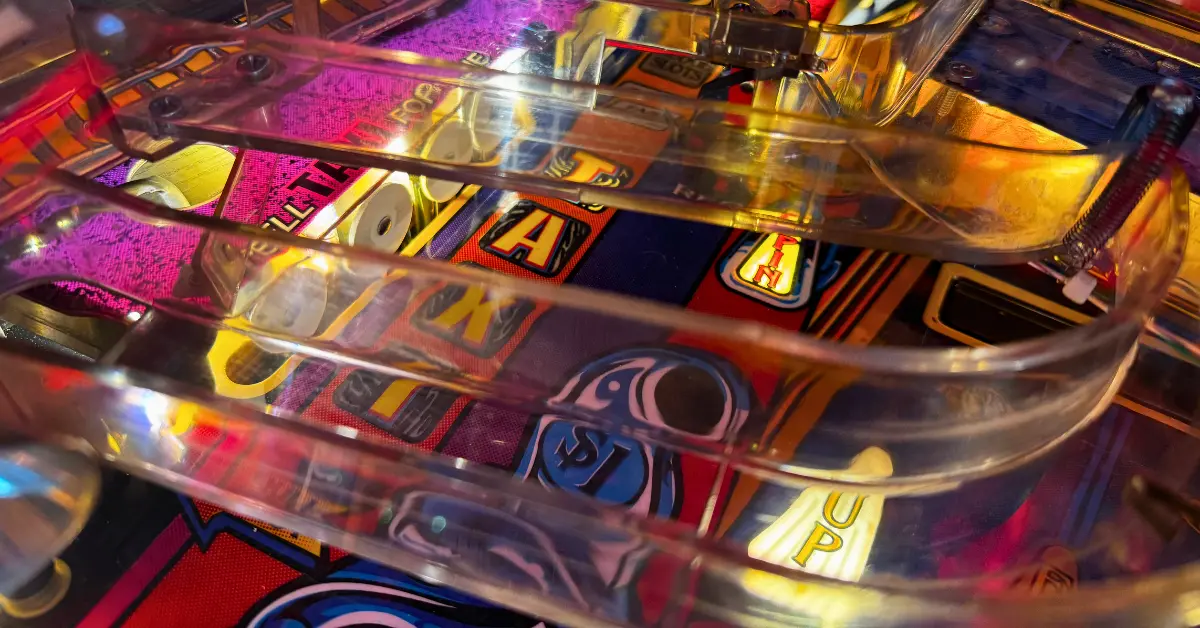
WHO dunnit has five different skill shot options, one for each letter of TAXI and a hidden super skill shot with a plunge into the left saucer. The lit skill shot strobes from top to bottom but the player can choose one themselves by pressing the left flipper to change which target is lit.
The skill shots are:
- T: Awards 10M points + 10M every time this option is scored or a super skill shot is made.
- A: Awards the next clue, lighting the phone in the process.
- X: Increases the bonus multiplier +1x.
- I: Lights the roulette award at the spinner. Does nothing if roulette is already lit.
- Super skill shot: Awards 20M + 20M every time scored, awards the next clue, increases the bonus multiplier by +1x, and awards a lock towards basement multiball.
The super skill shot is obviously the best of the five. Not only are the awards from it valuable, but if the player drains immediately after scoring a super skill shot (not flipping the ball or hitting anything besides the left inlane), the ball will immediately be deposited to the plunger again for another chance to score a super skill shot. This means that, with practice, players can start every ball with a sizable points lead and instant basement multiball, as the game neglects to punish players who take advantage of this switch validation rule.
Solving the Case & Roof Multiball
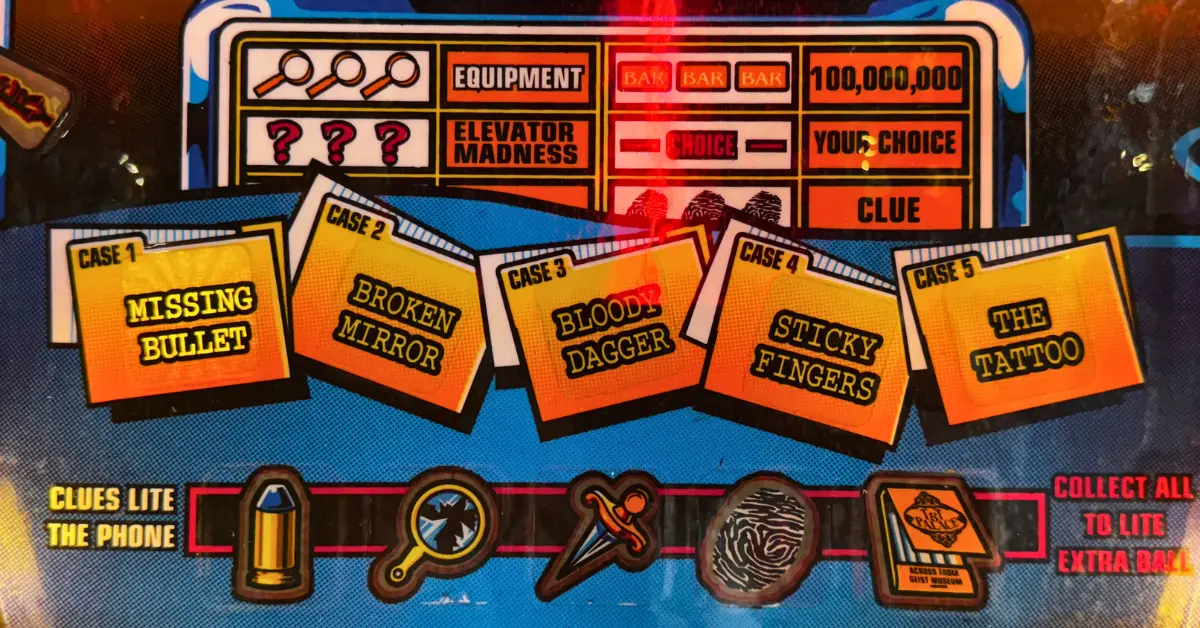
The main goal of WHO dunnit is appropriately to figure out who dunnit: all five of the suspects at Tony’s Palace have a tangled past and it’s up to the player to deduce what they’re saying and who could’ve committed each case.
To interrogate suspects, collect a clue and then shoot the phone. Clues are awarded every time TAXI is spelled by shooting either the TAXI targets or shooting the lit orbits when “taxi chase” is lit from the inlanes to spot letters. The player cannot stack multiple interrogations, though if who dunnit is lit, collecting another clue will light the phone for interrogation again. Collecting all five clues in a single case will light extra ball at the phone, then award 50M for each subsequent clue collected until the case ends. Evidence given from the elevator floors or map award can help pin down suspects easier than interrogations, and awards 25M for each evidence piece found.
After interrogating a suspect, the phone will be lit for who dunnit, allowing the player to select a suspect that they think committed the crime. The guilty suspect will always be the one who is discussed in the first interrogation, but there are two exceptions to this rule: if the provided info doesn’t match up with who Nick Spade asks for info on, it won’t be that suspect; and sometimes, Nick will instead ask for info about “Walter” or “Tex”. These refer to the dual lives of Butler and Bruno, respectively. Selecting a wrong suspect will still award points: 20M + 10M for each wrong suspect.
Selecting the right suspect or clearing out all four suspects through multiple who dunnits, will start a chase on the roof to catch the killer. The right orbit and left orbit will alternate being lit on a 12-second timer to start chasing after the killer; once either lit orbit shot is made, 25M will be scored and the phone will light for a hurry-up counting down from 100M points. Shoot the phone to arrest the killer and lock in the hurry-up value as a jackpot, before starting a 4-ball Roof Multiball where all shots are lit to score the jackpot value. Once Roof Multiball ends, the player will move onto the next case and progress on clues will reset.
Points are given in end-of-ball bonus for progress on the cases: 5M per case started, 1M per clue found, and 20M per case finished by catching the killer.
Elevator Awards
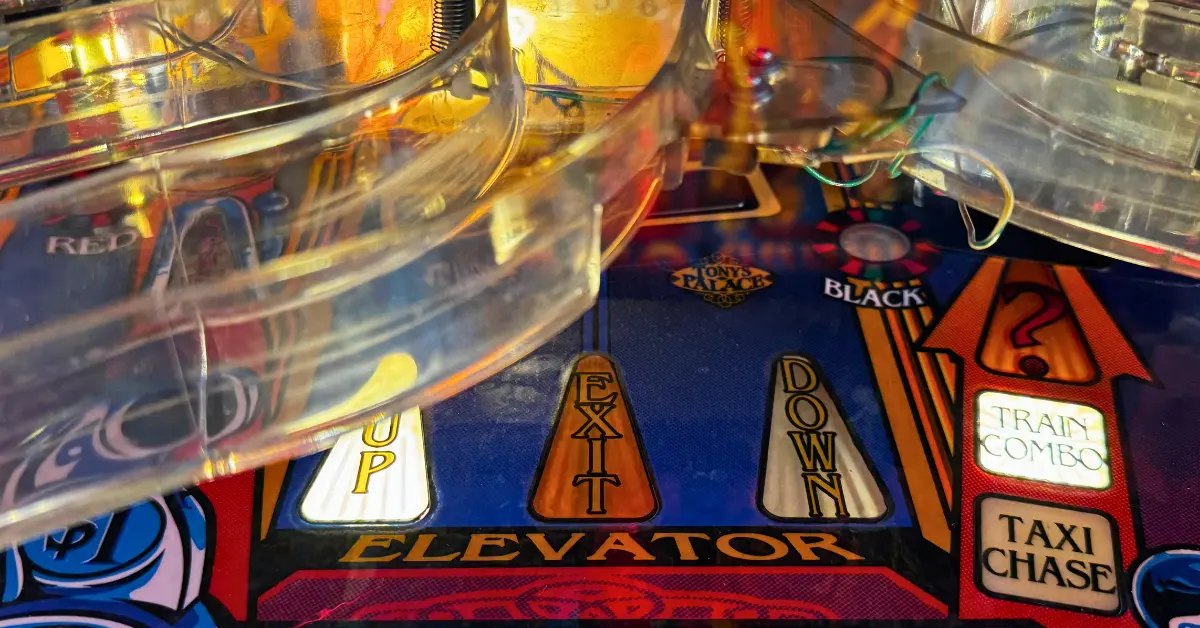
The elevator is the main gimmick of WHO dunnit and offers up an alternate method of play to more casual players. The elevator is open at the start of the game, but after scoring an award by shooting the exit ramp, the 3-bank target in front of the elevator will raise and must be completed to light the elevator again. This target also lights the “spin” shots when completed, so long as no other awards are lit at their respective lanes. The 3-bank target automatically lowers when the player starts roof multiball or collects second chance from the mystery slots, re-enabling the elevator award in the process.
There are 10 floors on the elevator, and once all 10 floors have been visited, the next elevator exit shot will immediately access the Roof for a chance to catch the killer (as described above). The “up” left ramp will move the player up a floor, and the “down” ramp on the right of the elevator will move the player down a floor.
From the bottom to top of Tony’s Palace, the 10 awards are:
- B: Starts basement multiball, described below.
- M: Lights the spin shots and roulette at the spinner.
- 2: Awards a clue, lighting interrogation in the process.
- 3: Collect evidence OR choose who dunnit (select with left or right flippers).
- 4: Spins the slots instantly.
- 5: Collect evidence OR choose who dunnit (select with left or right flippers).
- 6: Awards equipment (with priority given to revolver).
- 7: Elevator Madness 2-ball multiball. Every elevator shot scores a value between 10M to 35M, the value either increases or decreases as the “up” or “down” ramps are hit. To prevent abusing this mode, the 3-bank target will eventually start to lower and raise, blocking elevator ramp shots.
- 8: Interrogate suspect OR who dunnit (select with left or right flippers).
- P: Penthouse Party. 30-second timed mode where all shots score values starting at 10M and increasing by 10M to a max of 200M per shot. Make sure you collect the penthouse key at the right standup targets before accessing the penthouse.
Basement Multiball
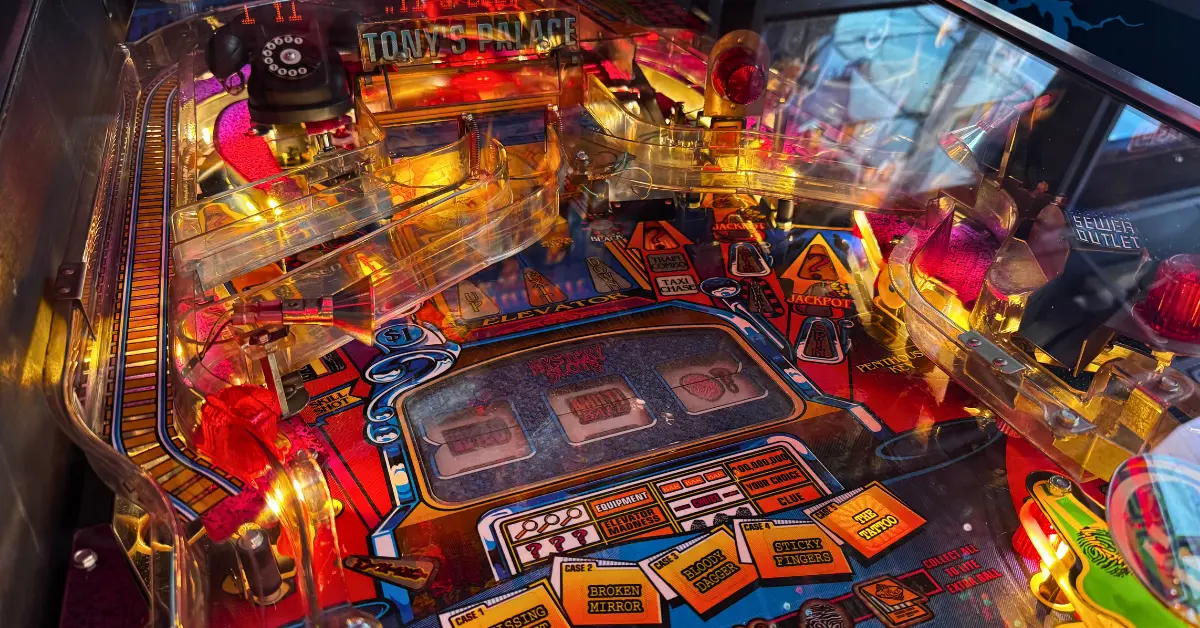
Basement multiball, despite being the “main” multiball of the machine, is inconsistently seen across games. There are three ways to start this multiball:
- The “intended” way is to lock balls at the left saucer, with 3 locks starting multiball. However, this saucer cannot be intentionally hit – balls need to land into it on their own. Super skill shots can help with making basement multiball easier to access. You can also supposedly shatz the left saucer with a very late right flipper shot, but I generally struggle with alley passes on these 90s Bally/Williams tables.
- Spinning “multiball” on the mystery slots will instantly start it.
- Accessing the basement floor on the elevator will instantly start it.
During basement multiball, three shots are lit for jackpot: the elevator ramps, the spinner, and the sewer. All three elevator ramps must be hit to score a jackpot and it can no longer be lit after one is scored there, but the spinner and sewer jackpots remain lit for the entirety of the multiball. The “mystery” target on the left will also award jackpots if it is lit.
The jackpot value starts at 75M and increases by 1M per bumper hit, or 5M per bumper hit if the player has the revolver equipment in their inventory. The maximum jackpot value is 500M making this possibly even more valuable than roof multiball if the jackpot is maxed, but the basement multiball jackpot value is much tougher to increase. This jackpot value is also held across players in multiplayer games due to a code oversight, so depending on the size of the jackpot, it might be a good idea to ignore cases and instead try playing for basement multiball.
Mystery Slots
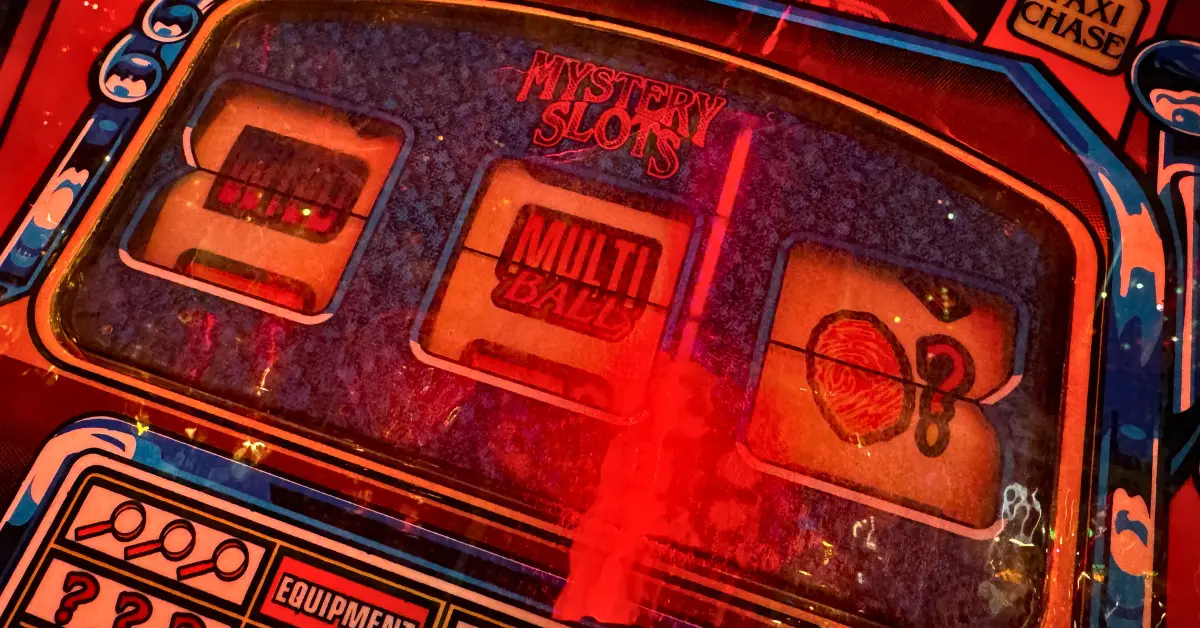
Nudge the mystery slots by shooting the left orbit when it isn’t lit: the ball will enter the bumpers, with each bumper moving one of the three slots downwards. If the three awards are matched, they will no longer change until the ball falls into the hole hidden behind the elevator. This “pict-o-pops” rule is one of Dwight Sullivan’s code signatures and would later reappear in machines like Game of Thrones and Teenage Mutant Ninja Turtles.
Spin the mystery slots by shooting any shot lit for “spin”, or draining down an outlane with Free Spin lit. The “spin” shots start the game lit, and can be relit by accessing the main floor on the elevator or completing the 3-bank target in front of the elevator. Spins can only be relit at shots that don’t currently have anything else lit: for instance, if interrogation or who dunnit is lit at the phone, it won’t light for spin.
Mystery slots can award any of the following based on the symbols:
- BARs: 100M points.
- Fingerprints: awards the next clue.
- Magnifying glasses: awards a random piece of equipment.
- Jackpots: awards a jackpot at current value (see: basement multiball).
- Multiballs: starts basement multiball.
- Extra Balls: awards an extra ball.
- WILDs: either act as a “wild card” match with two-symbol pairs, or if all three slots are WILD, accesses the Roof and starts catch the killer. The center slot has a “wild choice” that allows the player to choose between the award on the left or right slot!
- ?s: starts elevator madness 2-ball multiball. The ?s are hidden on seemingly normal slot symbol panels.
If the player fails to match any of the symbols, a consolation 5M is awarded.
If two symbols match, but one is incorrect, the player will receive a “second chance” that allows them to shoot any hole or saucer to collect the correct award and match the three symbols. If second chance is awarded from a Free Spin at either outlane, this will serve as a ball save and return the ball to play. This also occurs if the Free Spin awards either basement multiball or elevator madness.
Regardless of your luck with the slots, every spin of the mystery slots will add 5M to end-of-ball bonus.
Slot spins are given in a specific order on competition mode: clue, 5M, equipment, basement multiball, jackpot (second chance), 5M, 100M, then resets to the beginning.
Roulette

Roulette is a high-risk, high-reward feature that gives this game the “wow” factor for players who are willing to risk their current score. Shoot the spinner once to light the roulette, then again to select between betting part of your score or passing on roulette. Roulette is also lit from the “I” skill shot or by completing the first train combo of a game.
The percentage of score you bet during roulette increases and decreases with each spin of the spinner. At the start of the game, the minimum score is 25M and maximum score is 250M, but this increases as the player scores points, eventually reaching its maximum when the player reaches 2.5 billion: at which point 250M is the minimum, and 2.5 billion is the maximum.
If the player chooses to bet, they will either choose red or black based on which standup target they most recently hit prior to making the bet. If they guess correctly, the score will be added to their current score; but if they guess wrong, it will be removed, meaning this can possibly put an end to a promising start if the player is too greedy. Regardless of whether the player wins or loses points from roulette, choosing to bet on it will also increase the bonus multiplier.
In competition mode, the roulette will always fail on odd-numbered attempts, and always succeed on even-numbered attempts, regardless of which color target was hit before betting. If the player chooses to pass, then the order will move up by 1: for instance, if they pass on the first roulette shot of a game, then bet on the second roulette shot, it will fail.
Equipment

There are four pieces of equipment that can be earned through different methods. One equipment piece is given via accessing elevator floor 6, another is given by completing 2 train combos, and others can be scored through the mystery slots.
- Revolver: during basement multiball, the jackpots will increase by 5M per bumper rather than 1M. Typically given by accessing elevator floor 6.
- Magnifying glass: shooting the phone will eliminate a suspect if interrogation or who dunnit aren’t lit.
- Flashlight: the next shot to the unlit phone will find the magnifying glass, and the next sewer shot will find the map. Typically given by completing 2 train combos.
- Map: gives a sequence of awards with every sewer shot – bonus X, then interrogate suspect, then evidence, then who dunnit, then resets.
If all four pieces of equipment have been found, finding subsequent equipment will award a 100M bonus.
Train Combos
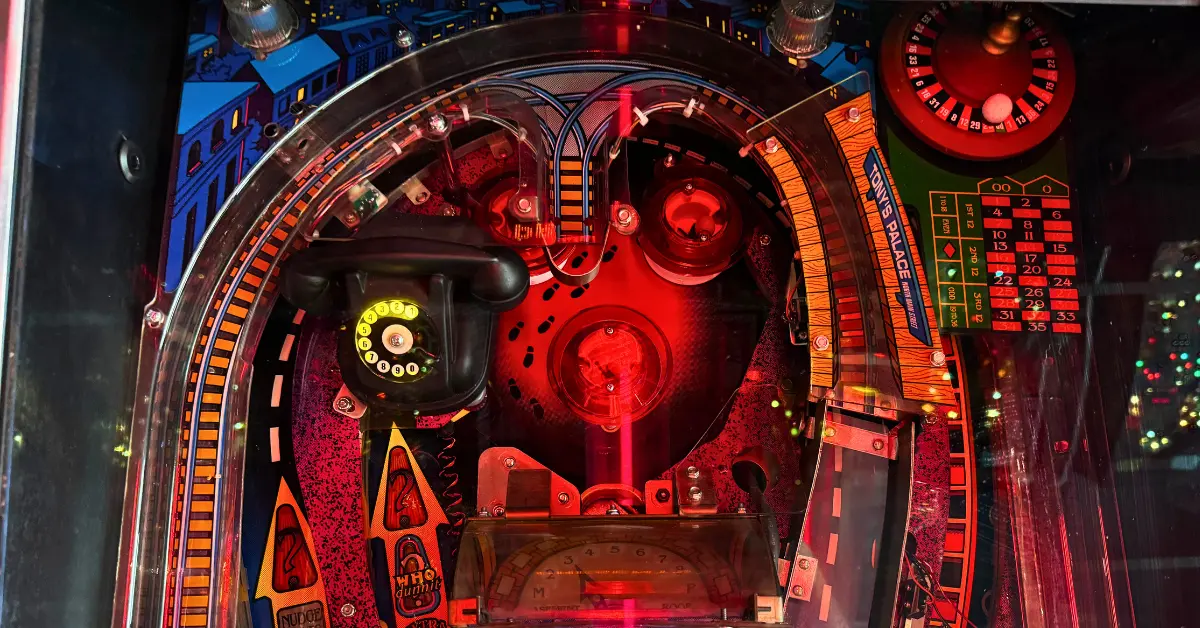
Shooting the train ramp when taxi chase isn’t lit advances towards train combos. Though these are called train combos, the awards are given for consecutive ramp shots, and the “train combo” lamp flashing simply means the next train ramp shot will give an award. The first train combo award is given at 2 ramps, then 3 ramps for the second, etc.
- 1st train combo: lights roulette
- 2nd train combo: awards equipment (with priority given to flashlight)
- 3rd train combo: lights extra ball at the phone
- 4th train combo: starts loop champion. The default loop champion is at 6 ramp loops and continuing to shoot the train ramp during the next 10 seconds increases the player’s loop count. No points are given for each loop during this mode, and loop champion is oddly never shown during attract mode, making this final award a bit of an afterthought.
Mystery Target
The left standup target can be lit to help with game progression whenever the penthouse key target on the right is hit. Despite being called a “mystery award”, the mystery target likes to give context-sensitive awards similarly to the ? target on Terminator 3: Rise of the Machines (also coded by Dwight Sullivan).
The logic behind the mystery target is as follows:
- If interrogation isn’t lit – award clue & light interrogation
- If interrogation is lit – light who dunnit
- If both phone awards are lit – award 25M
- During roof chase – score lit orbit
- During roof hurry-up – reset hurry-up timer
- During roof multiball – award jackpot
- During basement multiball – award jackpot
- During elevator madness – give 3 awards
- During penthouse party – give 3 awards & value increases
Noah’s Strats

- Master the plunger strength for the super skill shot. The strength varies across copies, but if you can pull off super skill shots consistently, you will be able to start each ball with substantial boosts to your score and bonus X, have the phone lit for interrogation, and have basement multiball primed to start. Just be sure to drain the ball after scoring the super skill shot so you can plunge for another one.
- If you aren’t as consistent with super skill shots, use the ball save to instead aim for the penthouse key targets on the right, and then shoot the mystery target for your first clue. You can simplify this progress by shooting for the “A” skill shot if your copy allows for it.
- The center 3-bank might be fun to hit but is very risky considering the awards that can be scored from the elevator. Try starting a multiball mode if you want to lower the 3-bank instantly, unless you’re confident in being able to recover from it; aim for it from the right flipper to reduce outlane drain risks.
- Make sure to play at least one round of roof multiball before considering going for the roulette. Ideally, you should be above 2.5 billion before aiming for the spinner. Of course, a bit of gambling can’t hurt - if you do lose points from betting on the roulette, you will still earn bonus X from it, meaning you can more than recuperate your roulette losses later in the game. Please don’t take this bullet point as “Noah approves of gambling so I should do it in real life!”, because I sure don’t lol.
- Don’t sleep on the train combos. The magnifying glass equipment can be earned by scoring the flashlight from train combo 2, then shooting the unlit phone, and effectively negates the entire “collecting clues / interrogations” aspect of the game in favor of being able to hit the phone four times to instantly access the roof.













